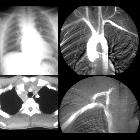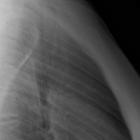Luxation Sternoklavikulargelenk
 ähnliche Suchen
ähnliche Suchen siehe auch
siehe auchSternoclavicular joint (SCJ) dislocation is rare, accounting for only ~2% of joint dislocations and especially when compared to other traumatic upper limb injuries such as clavicular fractures.
Epidemiology
Most cases result from indirect trauma , especially high-speed motor vehicle accidents. Spontaneous dislocations can also occur, these are typically anterior and occur in young men .
Associations
Sternoclavicular joint dislocations are associated with the following injuries :
- anterior dislocation
- posterior dislocation
- subclavian vascular injury
- pneumothorax
- esophageal injury
- cardiac arrhythmias
- brachial plexus injury
- tracheal injury
Clinical presentation
Anterior dislocation causes a palpable deformity. Posterior dislocations may be occult on physical examination but, due to compression of thoracic structures, present with dyspnea, stridor, or dysphagia.
Pathology
The injury can be broadly categorized into two types:
- anterior
- two-to-three times more common
- less serious
- posterior
- often occult clinically
- can be occult or subtle on radiographs
- potentially more serious because of the possibility of damage to mediastinal structures (e.g. great vessels, trachea, esophagus, etc.) as a result of posterior displacement of the medial clavicle head
- these injuries should prompt assessment of the mediastinal structures with CTA
Bilateral dislocations are easily missed on plain film imaging, a rare however necessary consideration, best demonstrated on cross-sectional imaging .
Radiographic features
Plain radiograph
- joint space widening at the sternoclavicular joint
- more easily visualized on an angled view, on this view inferior displacement of the medial head of the clavicle is indicative of a posterior dislocation, whereas superior displacement of the clavicle indicates an anterior dislocation
- difficult to determine anterior or posterior dislocation
CT
- joint space widening and asymmetry at the sternoclavicular joint
- associated injuries of the mediastinum
Treatment and prognosis
Options include conservative treatment, especially for anterior dislocation. Posterior dislocations are normally treated with closed reduction. Surgical fixation (ORIF) is usually reserved for unreduced posterior dislocations .
Thoracic outlet syndrome may occur as a late complication of posterior dislocation.
Siehe auch:
- Klavikulafraktur
- Articulatio sternoclavicularis
- Ruptur der Symphysis manubriosternalis
- Fraktur des Manubrium sterni
und weiter:
 Assoziationen und Differentialdiagnosen zu Luxation Sternoklavikulargelenk:
Assoziationen und Differentialdiagnosen zu Luxation Sternoklavikulargelenk:













